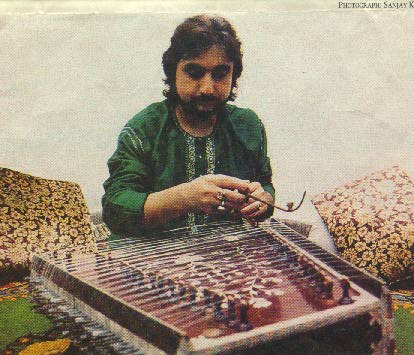|
Pandit Bhajan Sopori - The coolest one
- Ashish Sharma

Pandit Bhajan Sopori
Photograph: Sanjay K. Sharma
For Pandit Bhajan Sopori and music lovers, the
santoor is
a delightful reminder of the Kashmir Valley
The melodious tinkle of the
santoor instantly transposes you to the world beyond. Not without reason. The
instrument is integral part of Kashmir as the Jhelum. And Pandit Bhajan Sopori
is one of its celebrated exponents, despite having made the scorched concrete of
Delhi his home. But his tenuous links with the Valley haven't diminished the
magic quality of his santoor's mellifluous strains. If the achievement needed
affirmation, then the Sangeet Natak Akademi Award, which came his way recently,
is certainly one. The journey to the honour has been anything but simple.
Adapting the instrument to classical music has led Sopori, for instance, to
experiment with more than a dozen different forms with slight variations. Says
he: "I've moulded the original instrument according to my need. The
original santoor, which used to be played with Sufi devotional music, is an
instrument of one-and-a-half octaves, but my santoor is a three-octave device
and has an effective range of around four-and-a-half octaves. There are 100
strings, as in the original, but these are spread over 25 bridges, four strings
to each bridge. This helps in creating depth in the instrument and as the
vibrations traverse the octaves, the process is actually perceptible as in the
sarod and the sitar."
Sopori adds: "The idea isn't just to
brighten the instrument's tone, but also to add to the depth of the sur,
for that is what counts in classical music. Which is why I have been able to
play 30-40 minutes of alaap in my recitals and such complicated ragas
as Marwa and Megh. So much so, that I've played duets with
artistes of the stature of V. C. Jog, the violinist. Recently, I presented dhamar
to the accompaniment of the pakhawaj. Shortly, I'll be playing the tappa."
It is not that the instrument itself is a new creation.
Far from it. But there are conflicting views on its origin. Says Sopori:
"There are those who believe it was brought to India via Central Asia. But
the belief of our gharana is that it's the same instrument that was
popular in the Shaivite devotional tradition in Kashmir and then passed on to
the Sufi music legacy that overtook the Valley after the Conversion." This
is confirmcd by the fact that even the wood used in the manufacture of the
santoor has been traditionally worshipped. Also it has never been a lok vadya
as suggested in some quarters. It has always been associated with classical
devotional music. The son and disciple of Pandit S.N. Sopori has eminently
carved out a niche for himself. Performing in public for the past 36 years -
since the age of 10, in fact - his dedication has ensured a considerable
visibility on the concert circuit with innumerable performances in India and
abroad, many records in the market, a number of awards and the inevitable
disciples. He combines all this with a job in All India Radio and the constant
demands that are made on him as a music director. He has composed music for
telefilms (Mahaan, Zameen and Yatra), a TV serial on adult
education (Chauraha) and a number of short films on Kashmir. He's also
the music director of a series on love stories, being readied for telecast on
Zee-TV shortly.
Clearly, he has his hands full at the moment. Which is
something music lovers wholly approve of.
|
